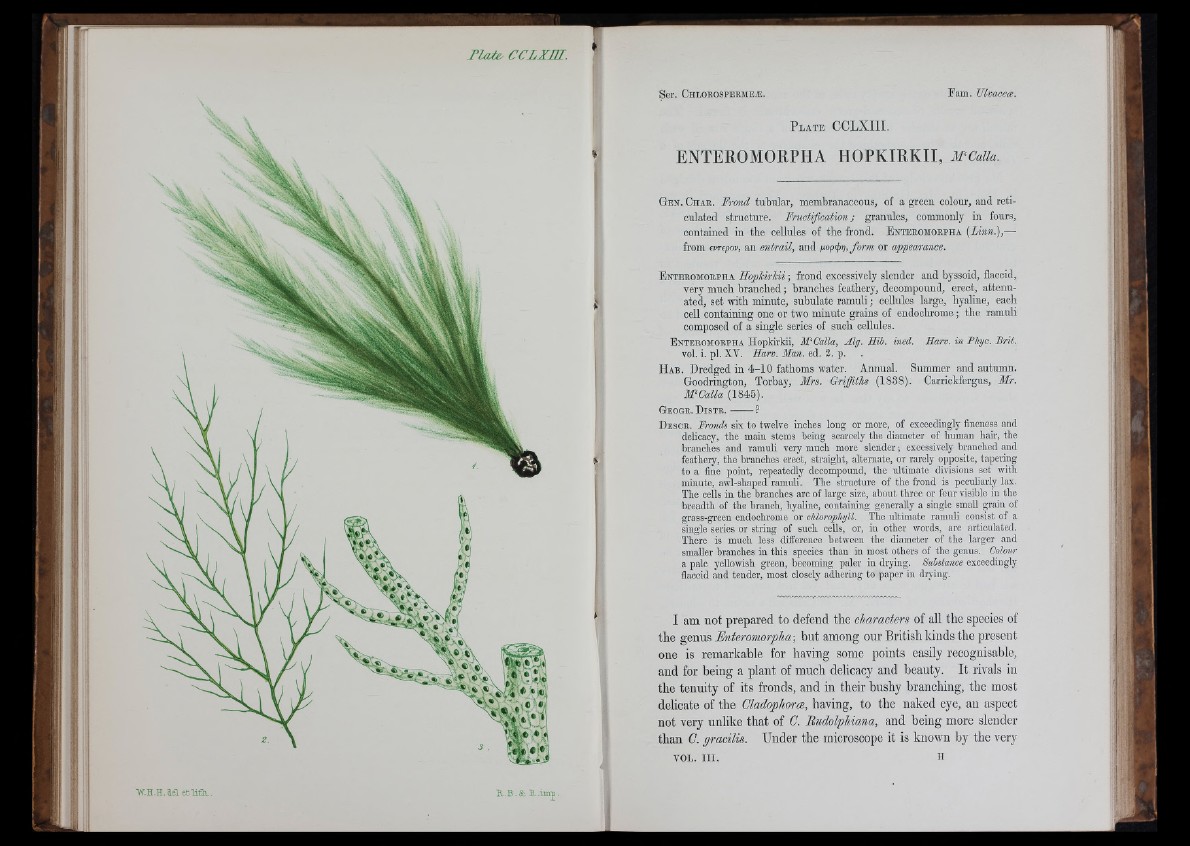
TLate. C C L XM .
P l a t e CCLXIII.
ENTEROMORPHA HOPKIRKII, M ‘Odia.
G e n . Ch a r . F ro n i tubular, membranaceous, of a green colour, and reticulated
structure. Fructification; granules, commonly in fours,
contained in the cellules of the frond. E nteromorpha (L in n ) ,—
from eprepov, an entrail, and p.op)>T], fo rm or i
E nteromorpha H o pkirkii; frond excessively slender and byssoid, flaccid,
very much branched; branches feathery, decompound, erect, attenuated,
set with minute, subulate ramuli; cellules large, hyaline, each
ceU containing one or two minute grains of endoclirome; the ramuli
composed of a single series of such cellules.
E n t e r o m o r p h a Hopkirkii, M'Calla, Alg. Hii. ined. Harv. in Phyc. Brit.
vol. i. pi. XV. Harv. Man. ed. 2. p.
H ab. Dredged in 4-10 fathoms water. Annual. Summer and autumn.
Goodrington, Torbay, Mrs. Griffiths (1838). Carriokfergus, Mr.
M'Calla (1845).
G e o g r . D i s t r . ?
D e s c r . Pronda six to twelve iuches long or more, of exceedingly fineness and
delicacy, the main stems being scarcely the diameter of human hair, the
branches and ramuli very much more slender ; excessively branched and
feathery, the branches erect, straight, alternate, or rarely opposite, tapering
to a fine point, repeatedly decompound, the ultimate divisions set with
minute, awl-shaped ramuli. The structure of the frond is peculiarly lax.
The cells in the branches are of largo size, about three or four visible in the
breadth of the branch, hyaline, containing generally a single small grain of
grass-gTcen endochrome or chlorophyll. The ultimate ramuli consist of a
single series or string of such cells, or, in other words, are articulated.
There is much less difference between the diameter of the larger and
smaUer branches in this species than in most others of the genus. Colour
a pale yellowish green, becoming paler in drying. Substance exceedingly
fiaccid and tender, most closely adhering to paper in drying.
I am not prepared to defend the characters of all the species of
the genus Enteromorpha; but among our British kinds the present
one is remarkable for having some points easily recognisable,
and for being a plant of much delicacy and beauty. It rivals in
the tenuity of its fronds, and in their bushy branching, the most
delicate of the Cladophorm, having, to the naked eye, an aspect
not very unlike that of G. Budolphiana, and being more slender
than C. gracilis. Under the microscope it is known by the very
VOL. I I I . II